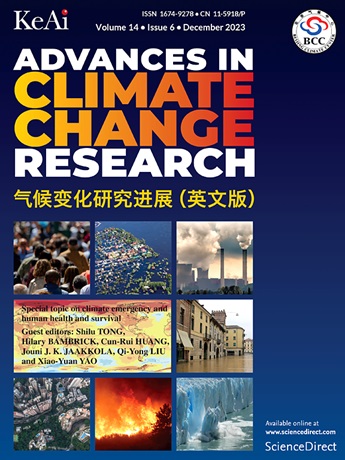Spatiotemporal pattern of ENSO-induced modulation on landscape fires over Pacific Rim from 2001 to 2020
IF 6.4
1区 地球科学
Q1 ENVIRONMENTAL SCIENCES
引用次数: 0
Abstract
While El Niño-Southern Oscillation (ENSO) modulates landscape fire activities across the Pacific Rim, the detailed patterns and mode-specific variations of these effects remain poorly understood. This study aims to address that gap by systematically assessing the spatiotemporal variations in burned areas from 2001 to 2020 during different modes of ENSO, namely, Eastern Pacific (EP) El Niño, EP La Niña, Central Pacific (CP) El Niño and CP La Niña. We evaluate the modulation patterns using classical correlation and cross-spectrum analyses, focusing on five hotspot regions: Temperate North America (TENA), Southern Hemisphere South America (SHSA), Northern Hemisphere South America (NHSA), Equatorial Asia (EQAS) and Australia and New Zealand (AUST). El Niño and La Niña exhibit asymmetrical opposite effects on burned areas, as expected. The findings reveal spatial non-uniformity in the impact of ENSO on landscape fires, with La Niña enhancing burned areas in TENA and SHSA, whereas El Niño predominantly affects AUST, EQAS and NHSA. CP and EP ENSO events differ in intensity and their large-scale circulation patterns. These differences cause notable variations in the regional burned area. Water vapour redistribution emerges as the key driver. The study emphasises the heterogeneity in ENSO modes in regulating landscape fires, providing insights for future landscape fire risk assessment and prevention efforts under climate change.
2001 - 2020年enso对环太平洋地区景观火灾调制的时空格局
虽然厄尔尼诺Niño-Southern涛动(ENSO)调节了环太平洋地区的景观火灾活动,但这些影响的详细模式和特定模式的变化仍然知之甚少。本研究旨在通过系统评估2001 - 2020年不同ENSO模式(东太平洋(EP) El Niño、EP La Niña、中太平洋(CP) El Niño和CP La Niña)的燃烧面积时空变化,弥补这一空白。本文利用经典相关分析和交叉频谱分析对5个热点地区进行了研究,分别是温带北美(TENA)、南半球南美洲(SHSA)、北半球南美洲(NHSA)、赤道亚洲(EQAS)和澳大利亚和新西兰(AUST)。正如预期的那样,El Niño和La Niña在烧伤区域表现出不对称的相反效应。研究结果揭示了ENSO对景观火灾影响的空间不均匀性,La Niña增强了TENA和SHSA的燃烧面积,而El Niño主要影响AUST、EQAS和NHSA。CP和EP ENSO事件在强度和大尺度环流模式上有所不同。这些差异导致了区域烧伤面积的显著差异。水蒸气再分布成为关键的驱动因素。该研究强调了ENSO模式在调节景观火灾中的异质性,为未来气候变化下的景观火灾风险评估和预防工作提供了见解。
本文章由计算机程序翻译,如有差异,请以英文原文为准。
求助全文
约1分钟内获得全文
求助全文
来源期刊

Advances in Climate Change Research
Earth and Planetary Sciences-Atmospheric Science
CiteScore
9.80
自引率
4.10%
发文量
424
审稿时长
107 days
期刊介绍:
Advances in Climate Change Research publishes scientific research and analyses on climate change and the interactions of climate change with society. This journal encompasses basic science and economic, social, and policy research, including studies on mitigation and adaptation to climate change.
Advances in Climate Change Research attempts to promote research in climate change and provide an impetus for the application of research achievements in numerous aspects, such as socioeconomic sustainable development, responses to the adaptation and mitigation of climate change, diplomatic negotiations of climate and environment policies, and the protection and exploitation of natural resources.
 求助内容:
求助内容: 应助结果提醒方式:
应助结果提醒方式:


